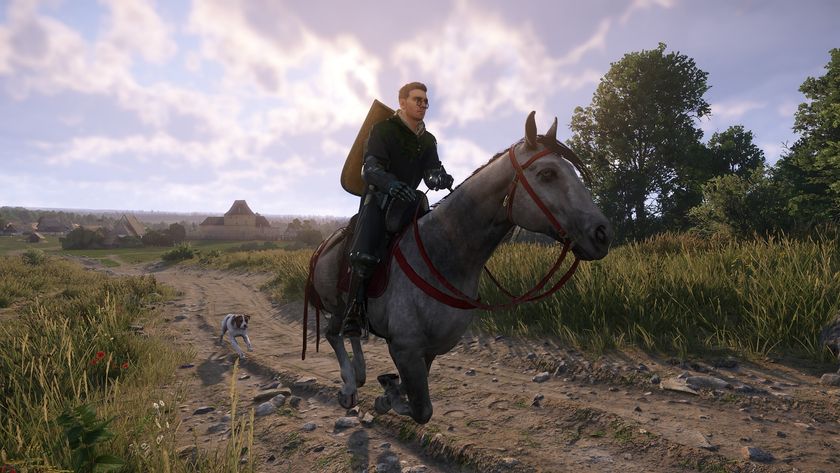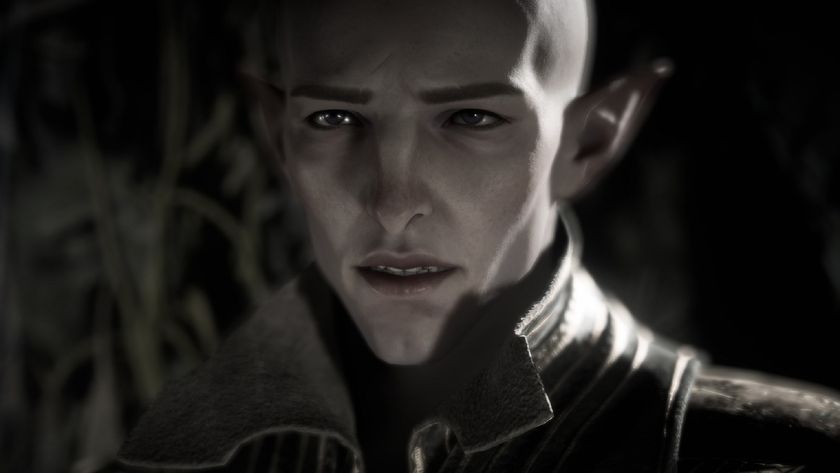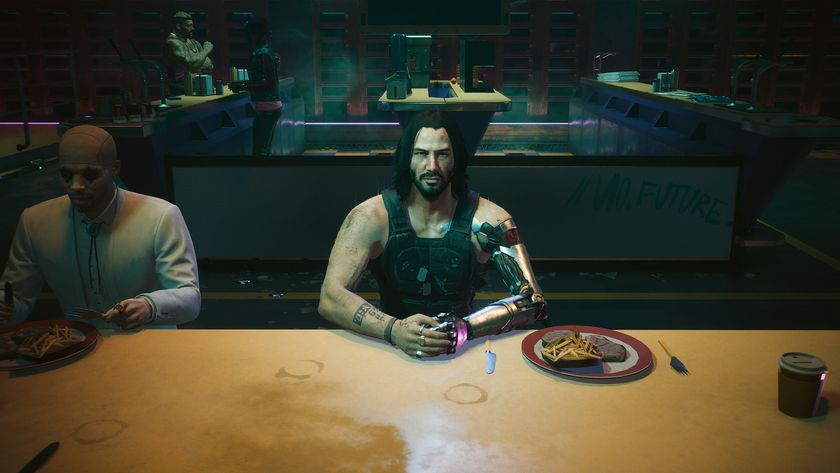Nier: Automata: Consistently great combat, in a world that sometimes feels desolate for the wrong reasons
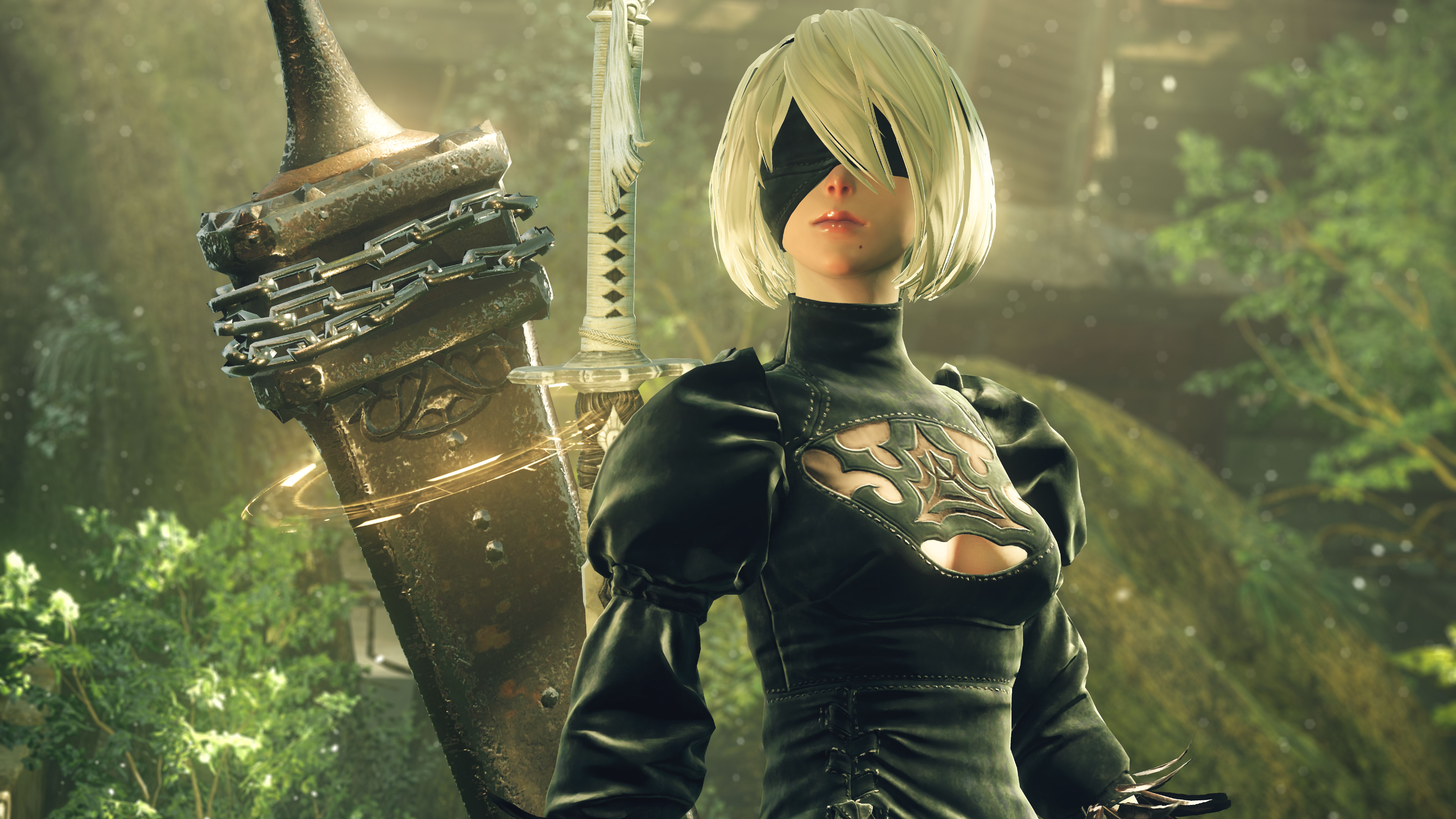
There’s initially something really, likably old-fashioned about Nier: Automata. From the off, it’s a video game that really wants you to know that it’s a video game. An action-driven, point-to-point jaunt from battle-arena to battle arena, by way of dialogue-churning, connecting corridors, all drama and apocalyptic ill-omen. It’s a controlled experienced, but a focused one, but also a game unafraid to mix up its more traditional elements with some modern versatility, making the familiar feel rather fresh and new by way of some neat tricks and (literal) spins.
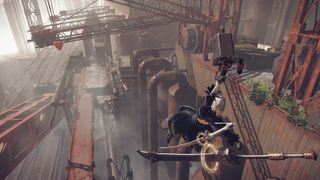
A quick, automated flick of the camera, and the game spins the viewpoint sideways, locking it to a 2D view on 3D action and converting robot protagonist 2B’s ascent up around a huge cooling tower into a tight, spatially demanding, side-scrolling battle. A bit like Nebulous with massive swords and laser drones. Or later, in wider arenas, the viewpoint might flip 90 degrees upward – sometimes mid-battle – giving things the feel of a twin-stick shooter.
The core gameplay systems will remain the same, but the way they’re presented will radically change the vibe, encouraging you through their presentation to try out new tactics and new ways to play. Top-down, with enemies all around, you’ll find yourself instinctively using 2B’s ranged attacks as a standard approach, ducking and weaving around enemy ‘droids to maintain optimum firing angles, throwing in her (objectively more powerful) melee attacks only as emergency, close-range measures. Side-on, the clearer perception of horizontal and vertical planes will encourage more aerial play, with launchers and juggle combos just far too tempting an option against the rows of hapless enemies cued up ahead.
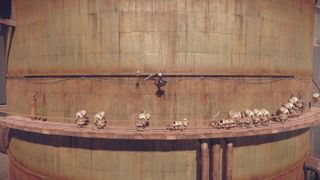
Not that that core action needs a great deal of messing around with in order to stay engaging. This is, after all, a Platinum game, and the Bayonetta dev’s hallmarks are obvious from the first couple of button presses. Immediately responsive sword attacks, fuelling combos of variable range and speed, flow outward in every direction with the minimum of effort.
There’s a smooth and instinctive lock-on/lock-off system for picking and choosing targets on the fly. A weak but useful long-range option – in this case powered by a flying drone gun – which can be used at the same time as melee attacks in order to maintain combos and keep wayward enemies busy while you deal with their friends. There’s also a special ability – served by a cooldown timer – which deals out charged laser bursts for huge damage, but which requires more careful, manual aiming for a few seconds. And that’s always a tricky risk/reward balance during Nier’s more hectic fights, which tend to take in grunt-swarms and omni-directional bullet-hell evasion – and the occasional huge, hulking boss – all at the same time.
Despite the increased flow of Stuff Going On, Automata is ceaselessly controllable. It’s the perpetual mantra of both the brawler and fighting game genres to proclaim ‘This is the accessible one! We’ve really cracked it this time!’, but with their action-RPG sequel, it’s believable that Platinum, working under Square-Enix, might have balanced the model vey successfully for both the pick-up-and-play contingent, and the developer’s more dedicated, combo-savvy fanbase. With attacks broadly divided between light and heavy, and two swords available for rapid switching, you need only hold down either button for set lengths of time to unleash multiple different flurries of highly effective violence.
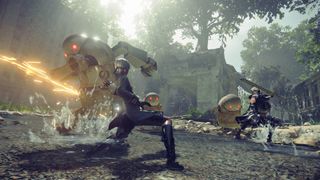
But while that’s perfect for the players who are coming to Nier for the story-led, ARPG side of the game, more seasoned players can get more versatility out of the same systems by just, well, not holding the buttons down. All the customisable, manual control you expect from a traditional Platinum game is absolutely present and correct if you just play it like one. Tap between light and heavy, vary your rhythm, switch your targets, and mess about with directional inputs and buffered jumps for juggles and smash-downs, and you’ll find yourself suddenly even more powerful. So far, Nier: Automata doesn’t feel like a game that actively demands this sort of play, but it’s one that certainly rewards it when you know what you’re doing.
Sign up to the 12DOVE Newsletter
Weekly digests, tales from the communities you love, and more
But it’s important that I flagged the game’s division into action and RPG halves up there. Because at the moment, Nier does very much feel like the product of two distinct components. And the latter part of its DNA is where the question marks currently hang.
Hitting the second half of my demo, I reach the open-world RPG component, freed to explore a lushly overgrown but decaying city. I’m immediately drawn in by the area’s profoundly affecting musical score, all loneliness, with morose, off-kilter strains, and lilting hope buried somewhere along the way. It’s a really distinctive sound, and one that immediately distils the appeal of Nier. It’s a post-apocalyptic sci-fi game about smashing up robots, but has a particular texture and tonal richness all of its own. In fact, so good is the soundtrack in instilling the game’s ambience that it takes me a good few minutes to notice what would otherwise be rather noticeable shortcomings
Yeah, here come the question marks.
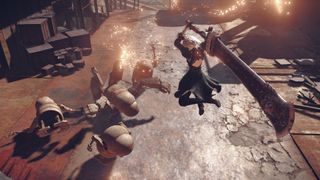
Because while the half-urban, half-jungle scenario might sound like The Last of Us, in execution its’ akin to playing The Last of Us’ imaginary PS2 prototype, all boxy rectangles, low-poly trees, and arbitrary invisible walls. Oh God, the invisible walls. I’m not talking about the architecturally justified, can’t-get-up-that-slope-better-find-a-way around variety here, you understand. I’m talking about the literal version. The kind where you can see an open doorway through a wall, leading to the clearing beyond, but bump into thin-air when you try to walk through it. And then have to find a way around for no discernable, logical reason. Couple this with environmental textures that vary between early last-gen and late-gen-before, and you have a strangely ambient, but severely antiquated setting.
Hitting the first town, the feeling continues. In truth, a self-contained huddle of NPCs and stalls within a yard between buildings, there are a few, key people to talk to – via on-screen text – a bunch of space-fillers, and a couple of side-quests to pick up before I can get into the main story. The weapon store owner needs some parts picking up from the wilderness. The general store keeper does too. So off I go, following the red spots on my radar to find their general locations, running face-first into invisible walls, and navigating alternate routes via alternate roots, sprinting and double-jumping up the sides of vast, twirling trees to make my way up, over, and through the architecture. There’s some light-but-fun explorative problem-solving to be had with this stuff, though there’s a perverse backward-world logic to it at the same time. This is, after all, a city where empty space is sometimes unswervingly solid, and nigh-vertical tree-trunks can be ascended on foot. Like I said at the top, video games.
Still, you don’t have to do everything on foot. With the right bait and a dose of pheromones – both available from the village shop – you can tame one of the giant deer ambling about the place and ride it to your destination instead. Which is very silly, and therefore obviously rather good. Again, very video games.
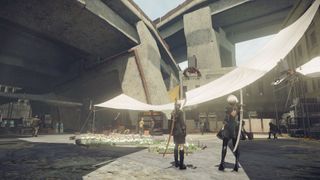
Arriving at my first objective though, I simply find a large, empty bit of parkland, and a bunch of enemies in the middle. I need to kill the baddos before I can search the area for the required McGuffins, and so kill I do. It’s a fun if unremarkable battle, because Nier’s combat is inherently fun, but the standard, wide arena doesn’t provide many bells, nor, in fact, any notable whistles. And then I hunt, prowling the grass for the pale yellow glows that indicate all of Automata’s loot, until I find enough of them squirreled away. This bit is, understandably, less fun.
And then I hit the second side-quest, and find that it plays out in exactly the same way.
But at least this triggers the first proper story mission, and makes both shops fully functional, kickstarting the diverse upgrade and character customisation system that looks to underpin the long-term game proper. And now, already, I’m being sent off to a brand new area. To the desert!
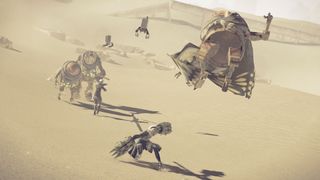
Alas, while the scope for character development is promising, this new area gives me little idea of what to expect from Nier’s long-term evolution in gameplay and design terms. Once I arrive I effectively discover another, wide, open area, only wider and opener (because it’s a desert) and a great deal oranger (because yep, still a desert). My initial mission objective is to – yes – find and kill a bunch of enemies indicated by red spots on my radar, and I dutifully do, finding that the fights are toughening up pleasingly, and are made a little more complex by an abundance of flying enemies requiring greater mix-ups between long-range and aerial attacks. But I’m still basically smashing up mobs of bad dudes before running through the wilderness to the next one.
And at the moment, that’s Nier: Automata all over. Brilliant, focused, intimate pockets of action, and great linear segments, with an uncomfortable feeling of emptiness in between. How the ultimate balance turns out, and whether it can rise above its antiquated world design to provide an overall experience with a home in 2017, we’ll find out when it releases early next month.
Most Popular







